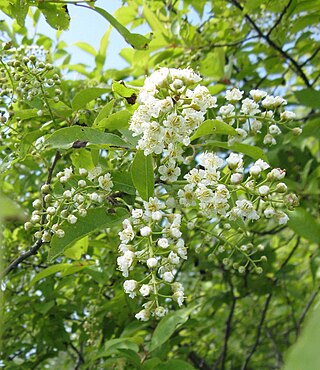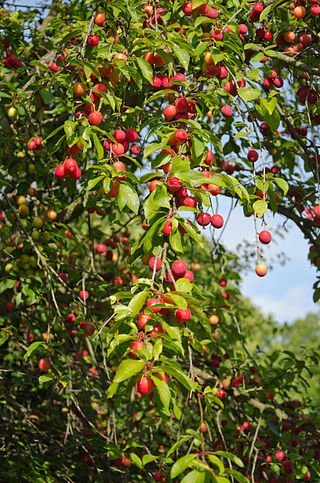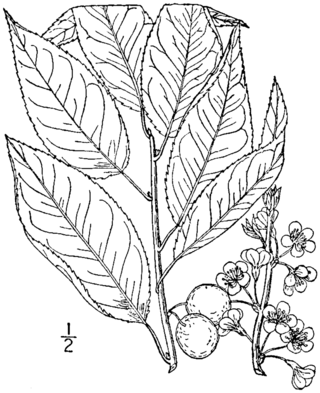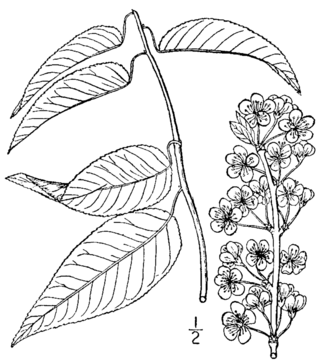
Prunus cerasus is a species of Prunus in the subgenus Cerasus (cherries), native to much of Europe, North Africa and West Asia. It is closely related to the sweet cherry, but has a fruit that is more acidic. Its sour pulp is edible.

Quercus muehlenbergii, the chinquapinoak, is a deciduous species of tree in the white oak group. The species was often called Quercus acuminata in older literature. Quercus muehlenbergii is native to eastern and central North America. It ranges from Vermont to Minnesota, south to the Florida panhandle, and west to New Mexico in the United States. In Canada it is only found in southern Ontario, and in Mexico it ranges from Coahuila south to Hidalgo.

Ptelea trifoliata, commonly known as common hoptree, wafer ash, stinking ash, and skunk bush, is a species of flowering plant in the citrus family (Rutaceae). It is native to North America, where it is found in Canada, Mexico, and the United States. It is a deciduous shrub or tree, with alternate, trifoliate leaves.

Prunus virginiana, commonly called bitter-berry, chokecherry, Virginia bird cherry, and western chokecherry, is a species of bird cherry native to North America.

Prunus cerasifera is a species of plum known by the common names cherry plum and myrobalan plum. It is native to Southeast Europe and Western Asia, and is naturalised in the British Isles and scattered locations in North America. Also naturalized in parts of SE Australia where it is considered to be a mildly invasive weed of bushland near urban centers. P. cerasifera is believed to one of the parents of the Cultivated Plum, Prunus domestica perhaps crossing with the sloe, Prunus spinosa, or perhaps the sole parent. This would make it a parent of most of the commercial varieties of plum in the UK and mainland Europe - Victoria, greengages, bullace etc.

Prunus maritima, the beach plum, is a species of plum native to the East Coast of the United States. It is a choice wild edible and its few pests and salt tolerance make it a resilient fruit crop for degraded lands and urban soils.

Prunus emarginata, the bitter cherry or Oregon cherry, is a species of Prunus native to western North America, from British Columbia south to Baja California, and east as far as western Wyoming and New Mexico. It is often found in recently disturbed areas or open woods on nutrient-rich soil.

Cephalanthus occidentalis is a species of flowering plant in the family Rubiaceae that is native to eastern and southern North America. Common names include buttonbush, common buttonbush, button-willow, buck brush, and honey-bells.

Prunus subcordata, known by the common names Klamath plum, Oregon plum, Pacific plum and Sierra plum, is a member of the genus Prunus, native to the western United States, especially California and Oregon.

Salix lasiolepis is a species of willow native to western North America.

Prunus nigra, the Canada plum, Canadian plum, or black plum, is a species of Prunus native to eastern North America.

Prunus mahaleb, the mahaleb cherry or St Lucie cherry, is a species of cherry tree. The tree is cultivated for a spice obtained from the seeds inside the cherry stones. The seeds have a fragrant smell and have a taste comparable to bitter almonds with cherry notes.

Prunus fasciculata, also known as wild almond, desert almond, or desert peach is a spiny and woody shrub producing wild almonds, which is native to western deserts of North America.

Viburnum nudum is a deciduous shrub in the genus Viburnum within the muskroot family, Adoxaceae.

Prunus mexicana, commonly known as the Mexican plum, Inch plum, and Bigtree plum, is a North American species of plum tree that can be found in the central United States and Northern Mexico.

Ribes aureum, known by the common names golden currant, clove currant, pruterberry and buffalo currant, is a species of flowering plant in the genus Ribes native to North America.

Celtis reticulata, with common names including netleaf hackberry, western hackberry, Douglas hackberry, netleaf sugar hackberry, palo blanco, and acibuche, is a small- to medium-sized deciduous tree native to western North America.

Prunus alleghaniensis, the Allegheny plum, is a species of New World plum, native to the Appalachian Mountains.

Prunus angustifolia, known commonly as Chickasaw plum, Cherokee plum, Florida sand plum, sandhill plum, or sand plum, is a North American species of plum-bearing tree. It was originally cultivated by Native Americans before the arrival of Europeans. The species' name angustifolia refers to its narrow leaves. It became the official state fruit of Kansas in 2022.

Prunus hortulana, called the hortulan plum and wild goose plum, is a fruit shrub in the rose family found in the central United States in: Arkansas, Iowa, Illinois, Indiana, Kansas, Kentucky, Massachusetts, Maryland, Missouri, Nebraska, Ohio, Oklahoma, Tennessee, Texas, Virginia, West Virginia. Populations east of the Appalachians probably represent naturalizations.























